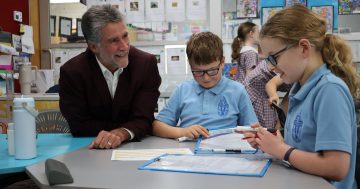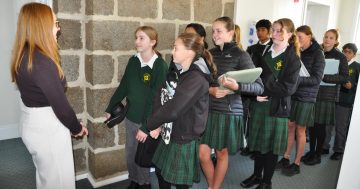
St Vincent’s Primary School Assistant Principal Monique Egan with keen readers. The school has achieved high results in NAPLAN. Photo: Catholic Education.
Is it time for ACT public schools to review its inquiry-based learning approach and look to what is being done in Catholic schools?
The latest NAPLAN results show ACT schools have done very well in reading but were consistently outscored by NSW and Victoria across all year levels and domains, albeit by small margins. But given the ACT’s socio-economic advantage, many believe Territory schools should do better.
Three years ago, Catholic Education embarked on a learning revolution through its catalyst program, adopting the explicit or direct teaching method based on brain science as its primary educational approach.
The NAPLAN results across reading, writing, spelling, grammar and numeracy show the decision is bearing fruit with schools such as St Vincent’s Primary School in Aranda achieving scores higher than the ACT, NSW and national averages.
Assistant Principal Monique Egan said the hard work of reorienting the school and rebuilding its pedagogical base was paying off, not just in higher academic standards but also in happier and much more engaged classrooms.
“Across the board, we had most children in strong and exceeding in both Years 3 and 5,” she said.
She said the new approach was not ‘back to basics’ or ‘drill and kill’ but based on how children could be engaged to learn.
“It’s the opposite of discovery learning because we believe you can’t discover something you don’t have any foundational knowledge in,” she said.
“So we are teaching first, and then we can move down that road [to discovery learning], but we have to give kids that instructional information first.”
Ms Egan said laying those firm foundations first allowed the school to teach in a much more effective inquiry-based way later.
This is complemented by constant reviewing of lessons throughout the year instead of isolated learning blocks.
Ms Egan said it was a very interactive, question-and-response type of learning that required students to be attentive.
Most students loved it, but for those who might struggle, teachers can make adjustments to ensure they were not left out or behind.
Ms Egan described the overall process as “I do, we do, you do”.
She said students were more engaged and focused, “and when you have more focused kids, you get more learning done”.
St Vincent’s had also found that students were better behaved.
With the new approach bedded down, some of those high-impact teaching practices were spreading to other curriculum areas as well.
“I’ve been waiting for this day for the brain science to actually begin to impact what we do in the classroom,” said Ms Egan, who has a Masters in Cognitive Science.

Catholic Education Archdiocese of Canberra & Goulburn Director Ross Fox: ACT community should expect better educational outcomes. Photo: Catholic Education.
Catholic Education Archdiocese of Canberra & Goulburn Director Ross Fox said the ACT as a community should expect academic outcomes that reflected its advantaged position, not just be on a par with NSW and Victoria which were vastly different communities.
He attributed the improved results seen in Catholic schools in the ACT and NSW to the dedication and focus of teachers and school leaders on high-quality instruction for students.
“Principals and teachers say a few years back that they would not have believed that students were capable of what they are now seeing in their classrooms,” Mr Fox said.
Improvements were not just limited to the ACT but in schools like St Mary’s Primary in Young where results were well above both ACT and NSW averages.
“They are getting an education there, based on the results, as good as and often better than many ACT schools,” Mr Fox said.
He said the focus was on high quality in classroom instruction. “If we get that right, 90 to 95 per cent should reliably progress,” Mr Fox said.
For those who might still need help, there was small group and individual response and intervention.
He said Catholic Education was quantifying results to provide an evidence base on the new approach.
He said an Equity Economics study sponsored by the Snow Foundation earlier in the year found significant improvement in performance against expectations in reading.
Catholic Education was also working with Deloitte Access Economics on a longitudinal study of the learning outcomes and work.
Internal assessment three times a year was giving teachers great feedback on student skills and knowledge in reading and literacy, and biennial testing was being implemented for reading and maths.
Mr Fox said that combined with NAPLAN, it was hoped that a whole picture of what was a complex and changing environment would emerge.
On whether the ACT Education Directorate should be taking notice, Mr Fox said teachers and education leaders should be focused on the most efficient and effective approach to learning.
Education Minister Yvette Berry said the ACT has continued to deliver a very strong and stable performance, with the proportion of ACT students achieving at the strong or exceeding level similar to or above the national average in all year levels and domains.
“The ACT has the highest or equal highest mean score performance across 19 of 20 year levels and domains,” she said.
All ACT public schools used both these teaching models and teachers made refined judgements about what is going to be the best balance of high-impact teaching strategies to meet students at their point of need.
This year’s NAPLAN testing adopted a new approach and cannot be compared with previous years. It used four ratings: Exceeding, Strong, Developing, Needs additional support.
Forty per cent of the ACT students are considered to be in the top socio-economic cohort, the highest in the country. In NSW, that cohort is just 27 per cent of students.





















